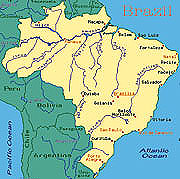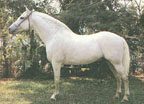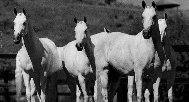Mangalarga Marchador by Christiana Guerra Brasil, one of the world's largest countries, with centuries of close political and cultural ties to Portugal and the Iberian peninsula, today boasts the largest population of horses descending directly from Iberian stock. More than 50% of all registered horses in this part of South America still reflect the influence and characteristics of the famous horses of the Conquistadors, the Jennet. Here, the Mangalarga, Crioulo and Campolina breeds account for 350,000 horses, twice as many as Quarter Horses. The most popular of them is the Mangalarga Marchador, the National Horse of Brasil.
Not unlike the horses of Andalucia or the coastal plains of Peru, the Mangalarga is the product of a rich agricultural area and its haciendas. There the farmers and ranchers have always valued an enduring horse with a smooth and comfortable ride and superb temperament. After all, they spent a large part of their work day on horseback. In 1807, when the armies of Napoleon threatened Portugal, the royal family withdrew to Brasil. They remained past the French occupation and, in 1815, made Brasil a separate kingdom. D. João VI succeeded to both thrones, ruling the home country of Portugal through a council of regency. When D. João left Portugal, he brought with him some of the finest horses of the breeding farm Coudelaria Alter do Chão. It is said that in 1812, Prince Pedro I, who later was named Emperor of Brasil, presented one of his fine stallions as a gift to his friend Gabriel Francisco Junqueira, Baron of Alfenas and the owner of the established breeding farm Hacienda Campo Alegre. Gabriel's father had established Campo Alegre and horse breeding seventy years earlier in the state of Minas Gerais. With its capitol city of Belo Horizonte, Minas Gerais was one of Brazil's richest areas, famous for iron, gold and diamond mining, cattle ranching and extensive agricultural production. With the arrival of the stallion Sublime, the foundation of the modern Mangalarga horse was laid. Sublime was bred to the native mares of Spanish Jennet and Barb blood, many of which were fast and smooth amblers. The first offspring produced from this cross were called Sublime horses. The name Mangalarga comes from the Hacienda Mangalarga which acquired stock from Campo Alegre and awakened interest in the horse among local ranchers. They soon began to go to the south of Minas Gerais to buy their own horses from Campo Alegre. The horses' smooth, cadenced and rhythmic gait, the marcha, contributed the second part to the name, Mangalarga Marchador. From these early beginnings, the Mangalarga Marchador has been selectively bred for over 180 years and it is said that no other breed has been crossed in. The first breeders organization, the Associação dos Criadores do Cavalo Marchador de Raça Mangalarga was established in Belo Horizonte in 1949 with the major goals to set breed standards and to promote and distinguish the Mangalarga Marchador as a unique breed, principally with regard to its gait. The group is now called the Associação Brasileira dos Criadores do Cavalo Mangalarga Marchador (ABCCMM) and boasts 7,000 members and close to 190,000 registered horses. When introduced to the neighboring state of São Paulo, some blood of Arabian, Thoroughbred and American Saddlebred origin found itÕs way into the breeding programs, leading to a separate registry of Mangalarga Paulista horses in 1934. The traditional breeding of Mangalarga Marchador horses though, has concentrated on the original pure foundation lines from Hacienda Campo Alegre. Genetic studies of these lines show many species with very little or no outside influences. These lines proved to produce horses that were sure footed, graceful, comfortable and of excellent temperament.
The Mangalarga Marchador is of good size with an average height of over 15 hands and weighing 900 to 1100 pounds. Horses smaller than 14.2 hands are not being accepted for registration. Most colors are represented in the breed with grays, bays and chestnuts being the most popular. The horses are well known for their keen intelligence, docile nature, undying stamina and regal bearing, but most of all, for their incredibly smooth and fluid ride even at high speeds. The head is triangular in shape with a straight profile and rounded over the nose region, typical of the Barb horse. The coat is fine and silky and the mane and tail are full. The neck is of medium length, sufficient for the horse to be well balanced for riding and reining. It is well arched and muscular, inserted in the top third of the chest to allow for a proud, high carriage. The thorax is deep and allows for great lung capacity, one of the reasons for the legendary stamina of the breed. The back is of medium length with short and well muscled loins. The gaskin and forearm tend to be long, well muscled and articulated and the cannons are short. The pasterns and hooves are at the slightly lower angle typical of Spanish horses. This allows him to overreach well and without excessive stress to his suspensories. The Gaits The Mangalarga Marchador has two special gaits or marchas, the marcha picada and the marcha batida. Which gait is superior is always subject to debate and it seems to boil down to the personal preference of the individual breeder. In Portuguese, picada stands for a light touch and of the two marchas, the marcha picada is a bit smoother. It is a broken pace and therefore creates little vertical movement. This gait is characterized by the movement of the animal's legs in a lateral sequence, with periods of triple hooves support. The principal advantage of this lateral four beat gait is its greater smoothness resulting from the periods of triple hooves support and from the overreach. The gait can be sustained for long periods of time, allowing the rider hours of enjoyable riding with little discomfort. The timing of foot falls is similar to the paso llano of the Peruvian Paso Horse. Batida means to hit and describes the gait considered to be a broken trot. It is characterized by the movements of the legs in a diagonal pattern, also with moments of triple support and a four beat sequence. This gait, unlike a trot, shows very little suspension (all the legs in the air) as the horses are always in contact with the ground. This creates stability and smoothness. The longer and more frequent the moments of triple hooves support are, the more comfortable the gait will be. On flat ground, performing the batida at a normal speed, the hind foot overreaches the track of the forefoot on the same side, adding to the smoothness of the ride. In this gait the timing of the footfalls is similar to the trocha gait seen in Colombian Horses.
Not unlike the Swiss army knife, the Mangalarga Marchador is very versatile and can fulfill many functions and perform a variety of tasks. They include the management of large agricultural farms and cattle ranches and a number of non specialized sports, such as cutting, endurance riding, trail and pleasure riding, jumping and polo. In 1994, two 60-year-old Brazilian men completed a 8,694 miles trail ride to prove the stamina of the Mangalarga Marchador. For one and a half years they rode all day and rested at night, all with the same horses. This was a defiance for the breed and the feat was recorded in The Guiness Book of World Records. In its effort to preserve and perfect the essential characteristics of the breed, the ABCCMM holds annual tests and competitions where conformation and type, gait and functional performance are being judged. The national points ranking system highlights the winning horses and breeders and many competitions attract exhibitors with cash purses. Gait classes are rigorous and normally last about an hour, during which the horse is judged for executing its gait with carriage, brio and elegance with consistent timing over a wide range of speed. Functional performance testing includes reining competitions, cross country events and endurance tests over distances from 32 to 62 miles. Top honors for breeding animals are awarded to horses with the high point score from a combination of all the above tests. Shows and competitions for Mangalarga horses are very popular all across Brasil. In 1995, the city of Belo Horizonte alone saw 27 shows and competitions with over 1500 exhibitors and close to 4400 horses. The tack used for the Mangalarga is simple. The saddle commonly used is similar to an Australian stock saddle. The headset is clean cut and a snaffle bit is usually employed. The attire used in showing the Mangalarga in Brazil varies from region to region but it is always colorful and unique.
Sources of Information about the Mangalarga Marchador: 1. Criação e Adestramento de Cavalos Marchadores (Breeding and Training Paso Horses) by Lucio Sergio de Andrade 19, Third Edition, 1992. Editora Líttera Maciel, Rua Hum 157, Cincão, Contagem, Minas Gerais, Brasil. 2. International Encyclopedia of Horse Breeds by Bonnie L. Hendricks, 1996. University of Oklahoma Press, 1005 Asp Avenue, Norman, OK 73019-0445. 3. ABCCMM - Associação Brasileira dos Criadores do Cavalo Mangalarga Marchador, Rua Goitacazes 14, 13º Edifício Bom Destino, 30'000 Belo Horizonte, Minas Gerais, Brasil.
|
 Origins
Origins  Breed Characteristics
Breed Characteristics  Performance and Versatility
Performance and Versatility  Expanding the Frontiers Outside Brazil, the Mangalarga Marchador has been received enthusiastically by Spanish horse aficionados and admirers of smooth four beat gaited horses alike. With its gentle temperament, stamina, comfortable ride, versatility and willingness to perform, this breed adds yet another color to the incredible mosaic of horses with Spanish ancestry around the world. Germany was the first foreign country to be conquered by the Mangalarga Marchador breed by the end of the 1980's. Today, there is already a well established German Mangalarga Marchador breeders association and the horses compete in many shows around the country. The breed can now be found in Portugal, Italy, Spain, Switzerland, Holland and many South American countries. Mangalargas finally arrived in the United States in 1991. The Brazilians, Gabriel Andrade and Lucas Guerra have pioneered the introduction of the Mangalarga Marchador to the United States and brought some horses to Miami, Florida. With its legendary stamina, excellent cow sense, great versatility and supported by the growing popularity of smooth riding gaited breeds, the Mangalarga Marchador is sure to be a great success here as well. As the Brazilian breeders association's motto says, it is truly a breed without frontiers.
Expanding the Frontiers Outside Brazil, the Mangalarga Marchador has been received enthusiastically by Spanish horse aficionados and admirers of smooth four beat gaited horses alike. With its gentle temperament, stamina, comfortable ride, versatility and willingness to perform, this breed adds yet another color to the incredible mosaic of horses with Spanish ancestry around the world. Germany was the first foreign country to be conquered by the Mangalarga Marchador breed by the end of the 1980's. Today, there is already a well established German Mangalarga Marchador breeders association and the horses compete in many shows around the country. The breed can now be found in Portugal, Italy, Spain, Switzerland, Holland and many South American countries. Mangalargas finally arrived in the United States in 1991. The Brazilians, Gabriel Andrade and Lucas Guerra have pioneered the introduction of the Mangalarga Marchador to the United States and brought some horses to Miami, Florida. With its legendary stamina, excellent cow sense, great versatility and supported by the growing popularity of smooth riding gaited breeds, the Mangalarga Marchador is sure to be a great success here as well. As the Brazilian breeders association's motto says, it is truly a breed without frontiers.